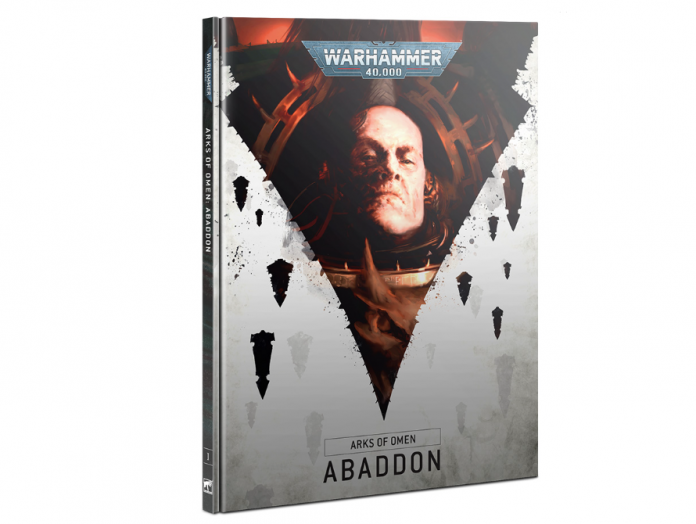Arks of Omen: Abaddon is the first of several books to be released by Games Workshop to serve as a galaxy-spanning series of narrative campaign books. The contents serve as a supplement to the Warhammer 40k 9th Edition Core Book and consist of a lore section and a rules section. The lore section focuses on the machinations of Abaddon the Despoiler and the force of Chaos as they continue the Long War against the Imperium of Man. The rules section covers Boarding Actions, a Patrol-scale alternative means of playing 40k.
The series consists of at least four books, but as specified in the Warhammer Community reveal there are likely more. The first three titles are Abaddon, Angron, and Vashtorr, and the fourth book is not named but according to GW “will be a distinctly xenos affair”. The Arks of Omen series appear ready to bring about a massive change in the lore of the Warhammer 40,000 universe, similar to how the Gathering Storm Campaign and Abaddon’s 13th Black Crusade resulted in the creation of the Great Rift and return of the Primarch Roboute Guilliman.
Before we dive in, we’d like to thank Games Workshop for providing us with a preview copy for review purposes.
The Lore
The section briefly synopsizes the lore of the first book, and we’ll do our best to avoid major spoilers, though it’s worth noting that Arks of Omen: Abaddon is relatively light on the revelations and major developments. Arks of Omen: Abaddon takes off shortly after the results of the Vigilus campaign as the Despoiler seeks out his next step in the defeat of the Imperium.
Rob: There’s a really cool bit of lore in here that talks about the difficulty actually leading the chaos legions, with Abaddon musing about the difficulty of managing a bunch of disparate warbands. It’s a cool setup for the Warmaster’s headspace as he figures out his next steps.
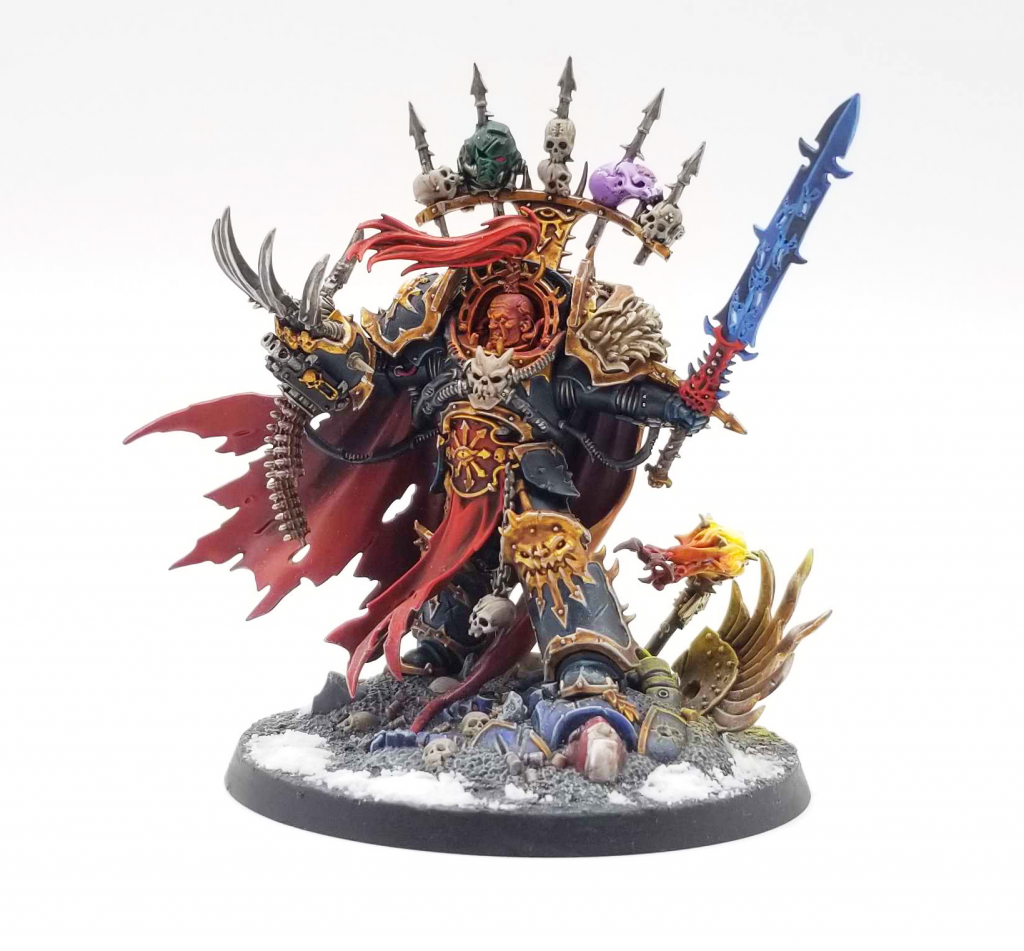
Abaddon
Abaddon the Despoiler was once the First Captain of the Luna Wolves, the legion of Warmaster Horus Lupercal. When Horus fell to the Emperor in their climactic battle above Terra, Abaddon fled into the warp to continue the fight of the Long War against the Imperium. Wielding the Talon of Horus and the daemon sword Drach’nyen, he has spent 10,000 years plotting and battling with the sole goal of doing what Horus could not and seeing the Imperium crushed. Although blessed by all four of the Gods of Chaos, he refuses to give himself fully to the Ruinous Powers and sees their presence as much of a threat as a source of power. The Sons of Horus were renamed to the Black Legion to purge the legacy of the failed Primarch, and over the course of the last ten millennia Abaddon has engaged in 13 Black Crusades to further his goals. His last Black Crusade saw him successfully murder the world of Cadia and bring forth the Great Rift that split the Imperium of Man in two. This victory enabled him to take the title of Warmaster, which he had previously refused. His final actions before the Arks of Omen series was to invade Vigilus and seal the Nacmund Gauntlet by destroying the Blackstone deposits located there. Doing so would doom the Imperium Nihilus and completely isolate them from Terra. His actions failed and Abaddon was forced to retreat.
In Arks of Omen: Abaddon the Warmaster is plotting his next action on The Vengeful Spirit when he is met by the demigod Vashtorr the Arkifane, who promises him an alliance that would serve both of their interests. If their efforts succeed, Abaddon would gain the weapons needed to pursue his goal, while Vashtorr would achieve his goal of ascending to become the Fifth God of Chaos. This plan would unleash a new age of terror and war across the Imperium.
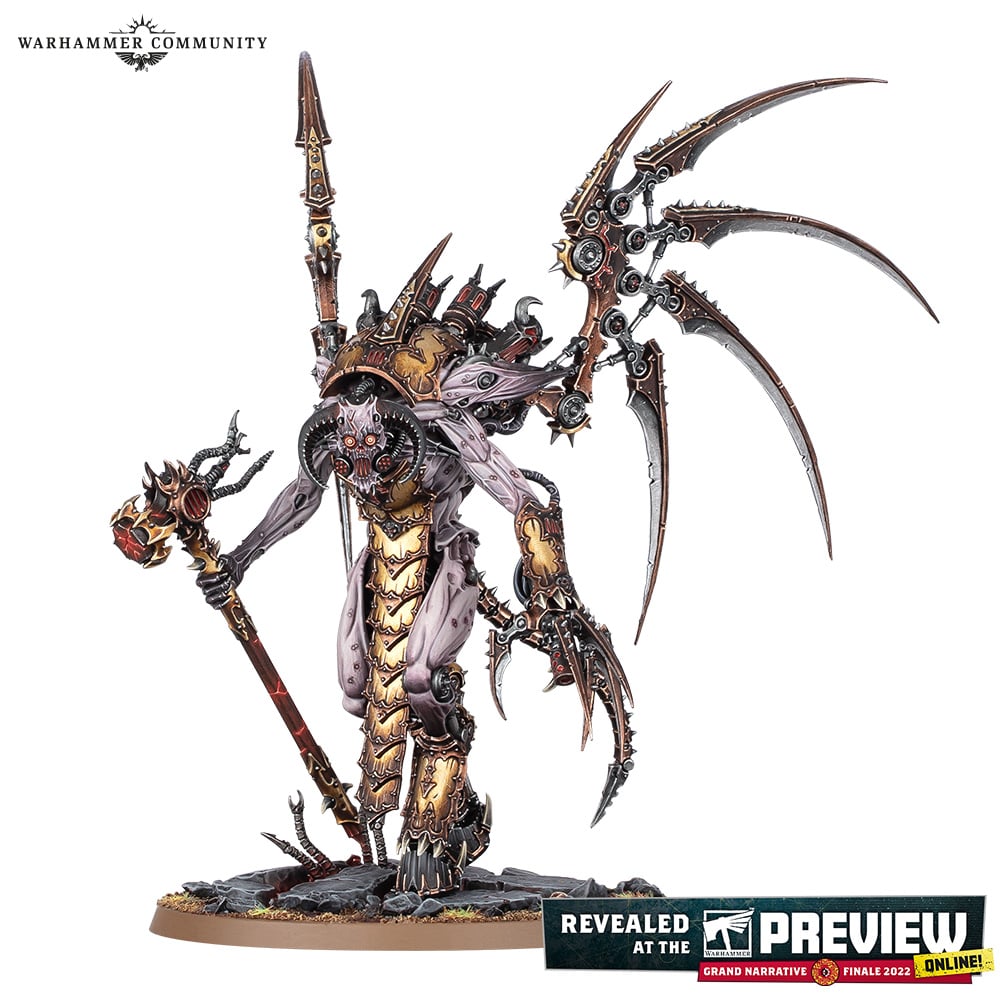
Vashtorr the Arkifane
Vashtorr is an independent daemonic entity, the demigod of inventors, engineers, scientists, and artisans. He is the extremity of innovation, of imagination and creation unbound by ethics or morals. Vashtorr gains power whenever a mortal mind is driven by curiosity to understand and exploit the forces of nature. He embodies the drive to achieve technological perfection, and the motivations between his own sphere of influence and the Machine Cult of the Adeptus Mechanicus are disturbingly aligned. Although similar to Be’lakor in that both are demigods, Vashtorr is not a Daemon Prince and is not beholden to any of the four Dark Gods. In contrast to other beings of the Warp, Vashtorr is unflinchingly direct in his communications and pacts. He says what he wants and the terms by which his power is shared are direct and to the point. He is the essence of an engineer.
Within the Warp, Vashtorr is the master of the soul forges, a metaphysical foundry in which daemonic entities are enmeshed with technological abominations to create entities such as Soul Grinders, Calamity Engines, or Infernal Bombards. Daemons willingly submit to this transformation in pursuit of swift power, agreeing in binding contract to pay the price of a given number of souls reaped and offered to the forges. He maintains his neutrality by being a useful entity to all of the Ruinous Powers. When manifested in reality he is a frightening threat that can summon forth hosts of infernal legions bound to him and alter the mechanisms of reality itself.
Being a daemon of calculated malice, his singular goal is to become a being of such power that he can rival that of the Dark Gods themselves. Vashtorr believes that the best way to achieve divinity is to fulfil the same prophecy that Abaddon pursued in the hopes of finding a weapon of incredible power. The pursuit of this prophecy would require the collection of multiple artefacts scattered across the galaxy which could be combined into something that Vashtorr called the Key. To find and return the Key-fragments would require vessels of immense power and capability, and Vashtorr had a plan for that as well: They would harness space hulks and form them into Arks of Omen that would lead Balefleets across the galaxy.
The Arks of Omen
A space hulk is an immense amalgamation of stellar debris, starships, and other detritus that have fused together after having been collected together in the warp over the course of millennia. These vessels are at a scale that’s difficult to fathom, potentially hundreds of miles long and consisting of vessels that can be older than the Imperium itself. When the vagaries of the warp unleash them into realspace, they often are infested with all manner of horrors and monstrosities that have been corrupted from exposure to the raw energies of the warp. Others may be filled with Orks hell bent on turning the hulk into the vehicle for their next great WAAAGH!, or Genestealers patiently waiting centuries for the opportunity to descend upon an unsuspecting world and form a psychic beacon to draw the Great Devourer. In the hands of Vashtorr and Abaddon, they are purged of a significant amount of their taint and reborn into Arks of Omen.
Once created, the Arks are placed under the command of Abaddon’s chosen followers and sent to their task, though not always fully aware of what they’re looking for. There’s some really cool details in the book on how these are outfitted and how Abaddon ensures they’ll achieve their goals, and it’s worth a read to understand more about the roles they play in the larger plan.
What’s Next
The lore of the first book ends on a bit of a cliffhanger, with the Arks of Omen being unleashed upon the galaxy as the forces of Chaos fight every race and faction in pursuit of the Key-fragments. The sheer magnitude of the operation has only just become apparent to the Imperium and Aeldari, and the full plans of Abaddon and Vashtorr are not yet fully known. There’s quite a bit more in store for the Imperium and it’s an interesting set-up to kick things off.
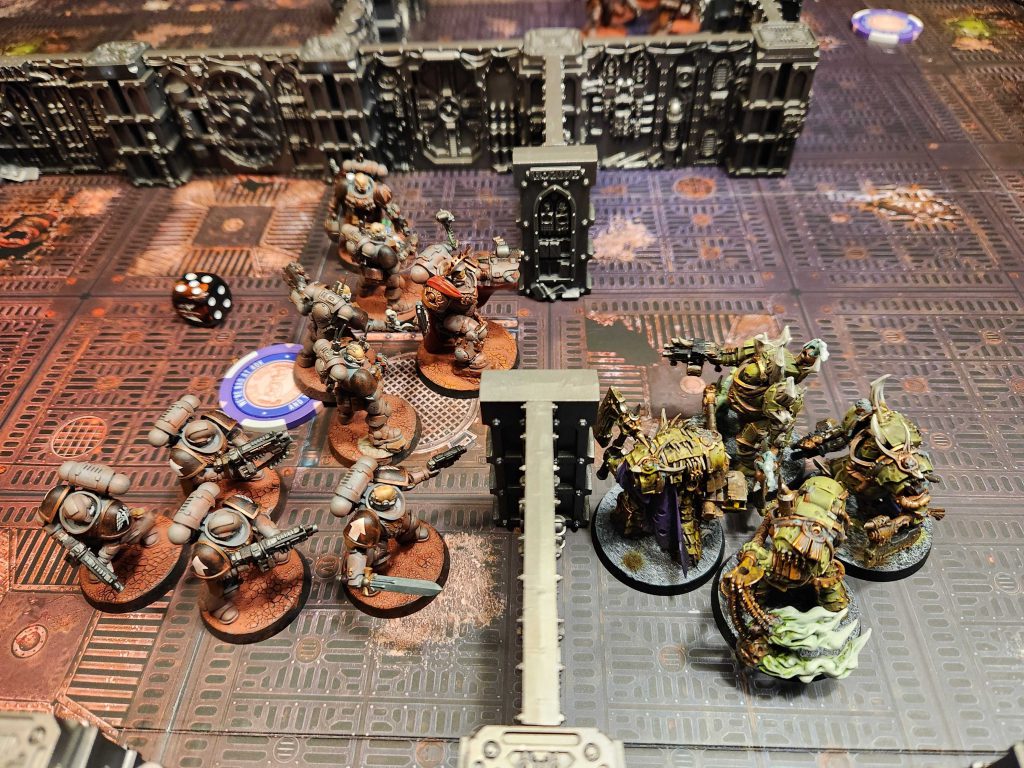
The Rules
The second part of the book covers Boarding Action battles, a variant of Warhammer 40,000 played with 500-point forces in the cramped confines of a space hulk. These games take place on a Boarding Actions Terrain Set, which is essentially two sets of Kill Team: Into the Dark Terrain laid next to each other. In practice, these function as a stripped-down version of the 40k ruleset, with very strict limitations on what types of units players can bring and a very limited set of upgrades and Stratagems to work with.
Terrain
Let’s start with what is simultaneously the most important and most limiting factor to Boarding Action missions: The Terrain. Everything here is designed around using the Board Actions terrain set, from the rules for interacting with doors to the missions themselves. they all have very specific guidelines for each piece of terrain and how the boards should be laid out for your games. For example, this is the deployment map for the mission Power Struggle, which sees players attempting to gain control of linked power nodes:
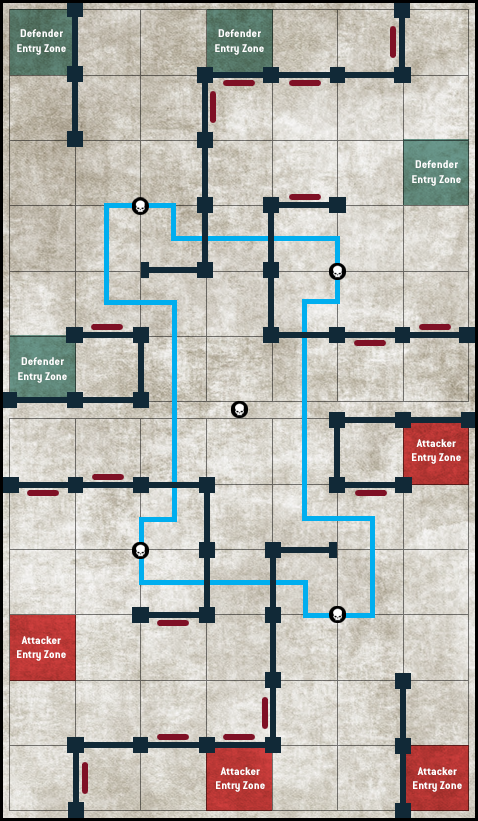
These mission layouts make it very clear how terrain should be placed, and everything from deployment zones to objective markers are laid out with this in mind. If you want to play this mode out of the box, you’re going to need this terrain. This may not sit well with players who have already spent hundreds of dollars on a Games Workshop or third-party Zone Mortalis board and aren’t inclined to purchase a completely new terrain set for a single form of play.
Assuming you have the terrain set available, the game board consists of two game boards laid side by side to create a long battlefield area. The terrain is the same system as provided by Into the Dark, consisting of columns, walls, and hatchways. The system is intended to be flexible and you do not want to glue the pieces into subassemblies, as all of the missions specify the board layout down to the position of individual wall section. Setup is very explicit about using the provided game board, which features a template where columns and walls can be located in a grid-like pattern. Each square that is formed by this grid is referred to as a Zone.
This is probably the biggest problem with the game mode, and something we’ll come back to later – while the Boarding Action terrain is very detailed and flexible, actually setting it up in a given configuration takes a significant amount of time and work, and disassembling a full layout to reassemble it for the next mission is a massive pain in the ass.
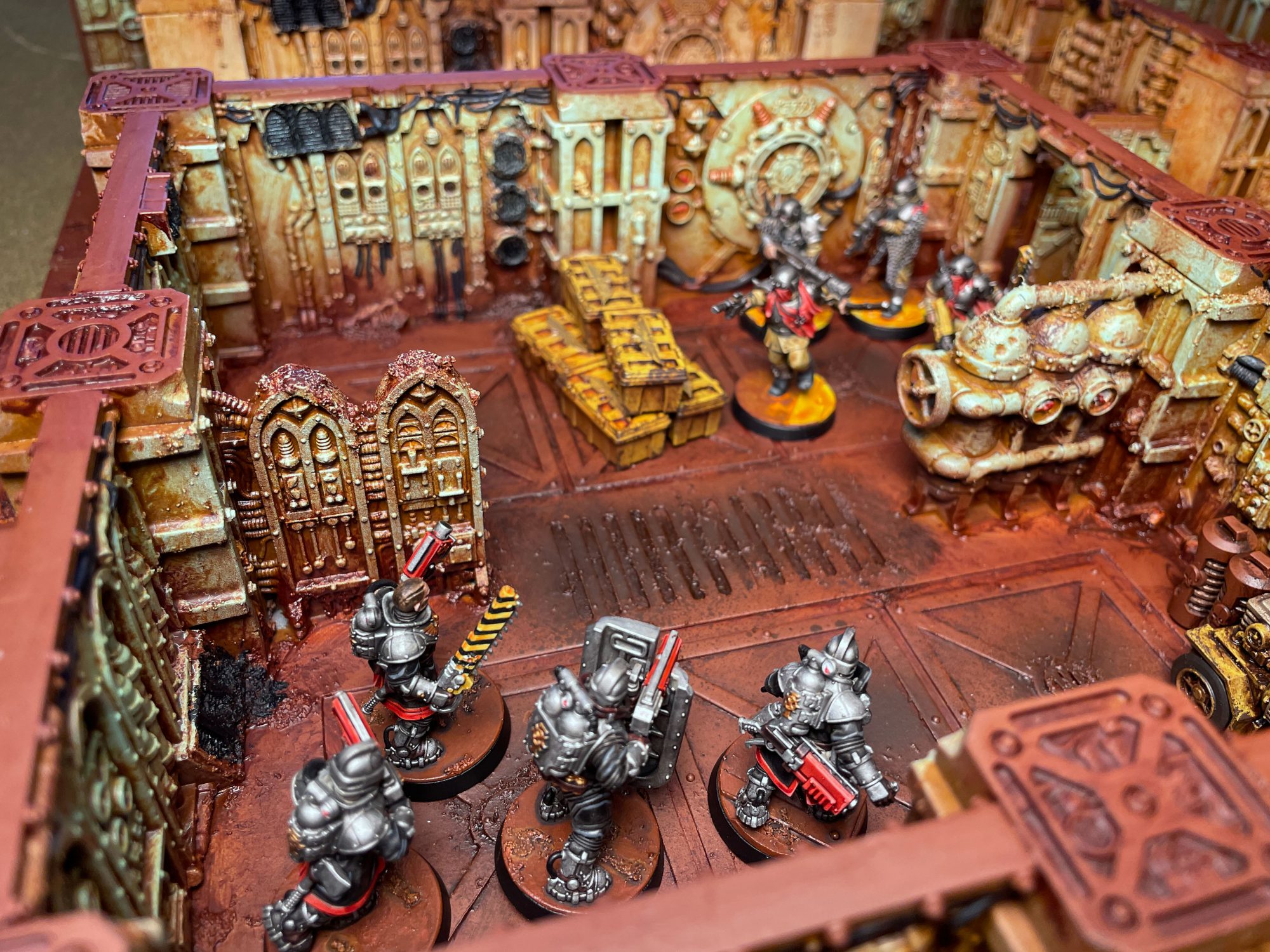
Boarding Action Games
This book provides the basic rules players need to play Boarding Actions games. Unless otherwise specified, all of the Warhammer 40k Core Rules and those found in Codexes and supplementary publications also apply. Here are the major differences:
CP and Stratagems
Players start each battle with 1 CP, and gain 1 CP at the start of each of their Command phases. CP can only be used on three Stratagems: Command Re-roll, Counter-Offensive, and Insane Bravery. These Stratagems are provided in the book but have rules that are identical to the Core Rulebook. No other Stratagems can be used.
This really simplifies things during games and if you’re the kind of player who finds modern 40k is too complex, this may be something of a boon.
Measurement, Range, and Visibility
Boarding Actions games use different rules for line of sight, cover, and visibility. Many of these will be familiar to Kill Team players who have played games in the Gallowdark.
- All measurements are done between the closest points of the bases of the models being measured, but measurements cannot be made through Walls or closed Hatchways. Instead a path must be drawn around those terrain features, and if it is impossible to draw a path then the distance between the models is considered to be infinite.
- Visibility is measured from base to base, and the model is considered visible so long as a straight line can be traced from any part of the observing model’s base to the observed model. The line cannot pass through a Wall, closed Hatchway, or a model that is not part of the observed model’s unit. Note that the open Hatchways do not block those visibility lines. If every portion of the target’s base is visible from the attacker’s base then the target is considered to be fully visible. If it’s only partially visible, it’ll get the benefit of cover.
- This means that models can easily block line of sight to other models if their bases are in the way, and it means you’ll want to set yourself up with gaps between your models for your own shooting purposes, and block those paths with your models when you want to play defensively.
- The presence of an open Hatchway can change Engagement Range. If the shortest path between two models passes through an open Hatchway then the models are considered to be in Engagement Range if they are within 2” of each other. This can lead to a unit opening a door and suddenly finding itself in Engagement range!
Allocating Attacks
Allocating attacks changes quite a bit as well. When allocating wounds for Ranged attacks, unless a model in the unit has already lost wounds or had attacks allocated to it that phase, a player has to first allocate attacks to a model visible to the shooting unit. This process also stops when there are no more visible models, so unlike in 40k where you can kill units around a corner with a unit’s shooting attacks, in Boarding Action games once you run out of visible models, you stop resolving attacks.
You Pretty Much Always Need Line of Sight
There are a number of line-of-sight based changes in Boarding Actions; Witchfire powers can only affect visible units, and powers that affect the closest unit need a visible target. Most important is the change to charges: You can only charge a unit within line of sight, and likewise you need line of sight to Heroically Intervene.
There are a few other tweaks; units that pile in and consolidate have to get at least one model within Engagement range of an enemy model for the unit to be able to perform the move. But on the whole, Boarding Actions games play pretty close to standard games of 40k, albeit with some more intense rules about cover and many more actions being performed.
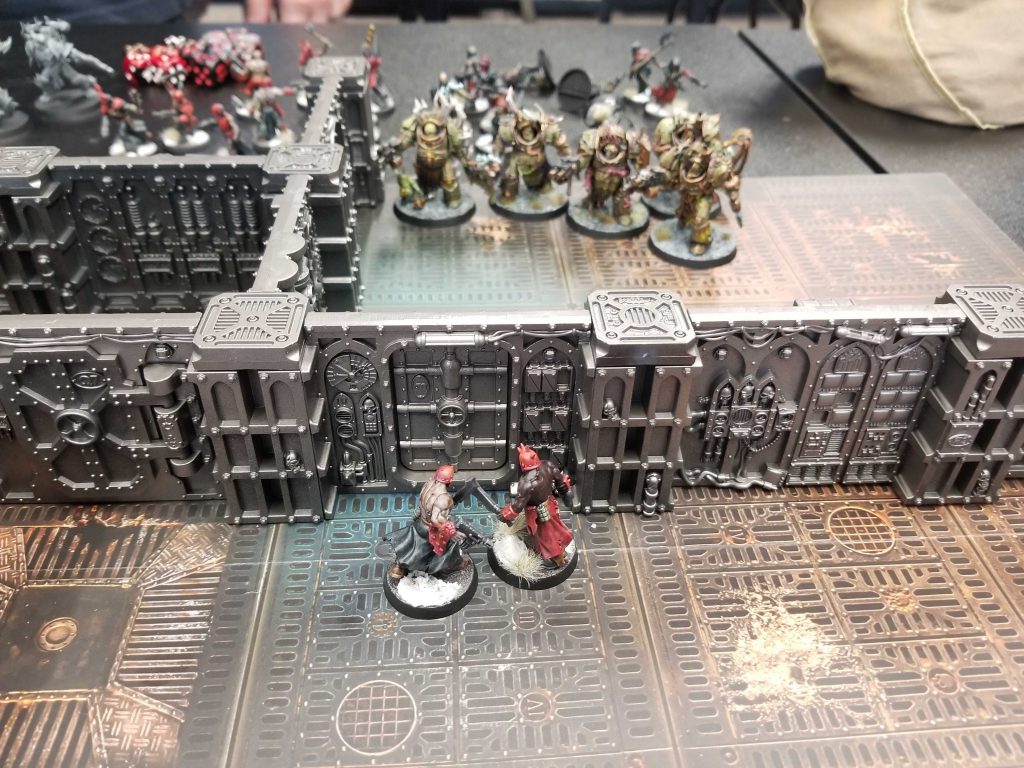
Actions
In addition to the actions available in the Core Rules, there are three new actions specific to Boarding Action battles. All of them are started at the end of the Move Units step of your Movement phase, which means you can’t do them with Reinforcements.
- If a unit has Objective Secured then they can use Secure Site to make that objective “sticky,” i.e. they maintain control of it even if there are no models around it, until an enemy controls it. This one finishes at the start of your next Command phase.
- The second action is Set Overwatch, which a unit can start at the end of the Move Units step of their Movement phase and completes at the end of their turn. After doing this action, that unit can shoot during the opponent’s movement or fight phases, opting to shoot at a unit which just finished moving or opening a hatchway (and only the unit that just finished moving), but it can only shoot a unit in Engagement range of it if that unit just finished making a charge move. This is resolved the same as Overwatch attacks, and as with standard 40k there are ways to Hold Steady so you hit on a 5+.
- The third action is Set to Defend, which is performed at the end of the Move Units step of the Movement phase and takes effect at the end of the player’s turn. This is like the fight version of Overwatch, and gives you a +1 to hit in melee during your opponent’s next turn.
- The final action is Operate Hatchway, which unsurprisingly covers what happens when you open or close a hatchway. This one is performed at the end of the Move units step of your Movement phase and completes at the start of your Shooting phase, allowing you to walk forward, open a door, then shoot or charge through it in a subsequent phase.
Rob: These translate some of the base mechanics from 40k very elegantly and I’m very impressed with these and how they’ve evolved them from 9th edition’s core rules. I’m kind of shocked that Secure Site isn’t already a mechanic in the core rules because it’s absolutely brilliant. Likewise, Overwatch and Set to Defend are both intuitive and make a lot of sense here, and I like those implementations as well. It’s pretty easy to remember these four actions in-game and Overwatch in particular can make flamer/autohit units extremely deadly for protecting ground and holding enemies off – my test games saw it turn the Foul Blightspawn into an absolute monster. These actions are great and they fix issues like units dropping in from teleport and doing an action.
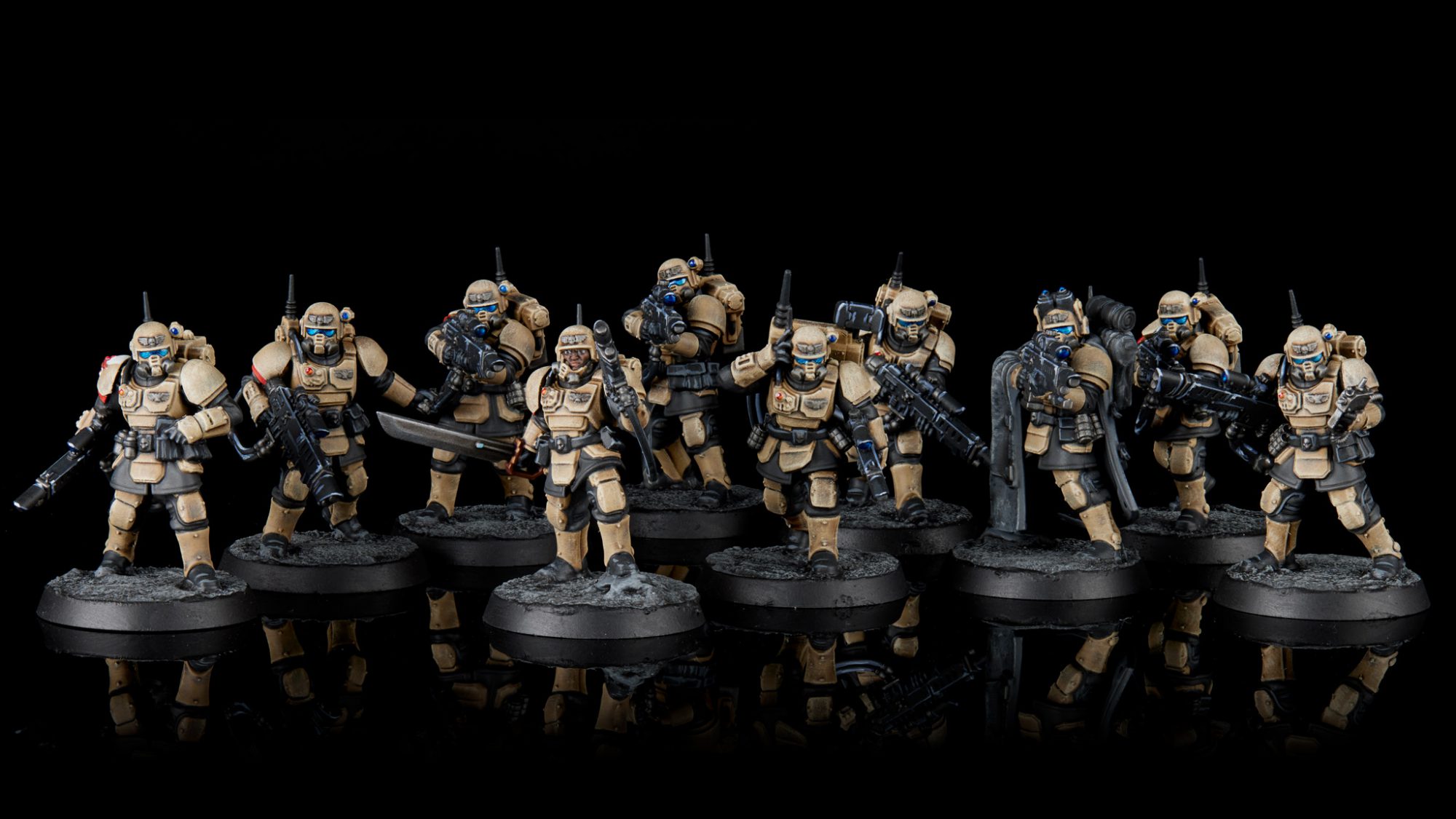
Mustering a Boarding Patrol Army
The rules for creating a Boarding Patrol are clearly intended to both create a very thematic force and also solve some balance issues inherent in small games. A Boarding Party always consists of up to 500 points’ worth of models that fit into a Boarding Patrol Detachment (0-1 HQ, 0-3 Troops, 0-3 Elites). You are limited to a single CHARACTER model (unless your faction has rules that say otherwise – see the Boarding Actions army mustering doc GW put out this week), and you may not have any models with the MONSTER, VEHICLE, JUMP PACK, CAVALRY, BIKER, or FLY keywords. Note that if you do not take a CHARACTER in this force then you do not gain access to any Boarding Action Enhancements.
The other limitation is on unit size. There are four key limitations here:
- First, if a unit’s minimum size is less than five then it can only be included in a Boarding Party if the unit is minimum-sized. This means that if you take something like a unit of Chaos Spawn, it’ll only be a single model.
- Second, if the unit’s minimum size is five then you can either use it as a minimum size unit or include additional models so long as the Starting Strength of the unit is 10. Note that for the most part, 10-model units are then split into Boarding Squads of five models before deployment.
- Third, you cannot include units with a Starting Strength greater than 10.
- Finally, you cannot include any Understrength units.
In addition to all this, there is also an Underdog Bonus for the player with fewer points, if the difference between the two armies is more than 30 points. This particular bonus depends on the mission.
While these rules seem restrictive, Games Workshop has offered some flexibility in the form of a Boarding Actions Mustering Rules PDF which provide exceptions and rules adaptations for different factions. For example the PDF includes rules for an Agents of the Imperium boarding party that apparently will get access to Adeptus Arbites (!), allows Space Marines to bring a Lord of War so long as it’s a Primarch, lets Chaos players bring Spawn despite it being a Fast Attack choice, and lets T’au bring Stealth and Crisis Suits despite those having FLY.
This is huge, and it’s great that GW put out the document because ultimately the limitations were brutal to some factions – without suits, T’au functionally couldn’t field a 500-point force without taking three units of Kroot Farstriders. These limitations will likely still benefit some factions more than others – Deathwatch in particular seem like they’ll be able to pull off some real nonsense using the ability to mix teams – but on the whole the PDF update really helps smooth a lot of this out, and we’re glad it came out before the book’s release.
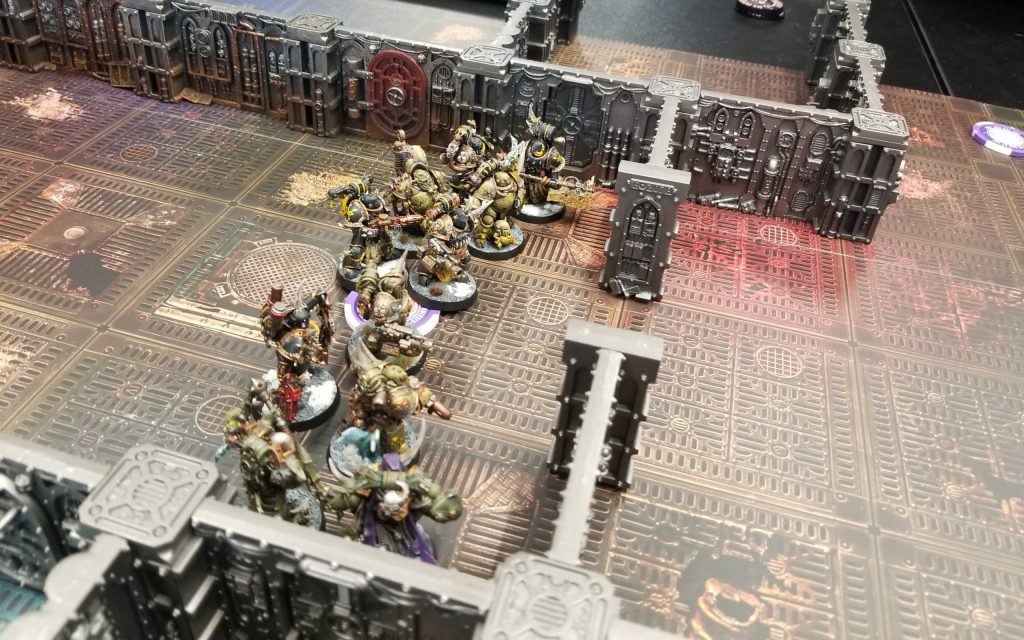
Boarding Action Enhancements
In Boarding Action battles players cannot use any Warlord Traits or Relics (out of the box, anyways – it seems like we’re set to get some in future books, thanks to Warhammer-Community previews). Instead, they gain access to a series of Boarding Enhancements, which function in a similar fashion. Each Warlord can be given a single enhancement (named characters get nothing) from a list of the six offered. These range from Superior Boarding Tactics, which gives you +2 CP to start with to Personal Teleporter to give you deep strike to Trademark Weapons, which replaces your relic options by letting you make a single weapon Strength +1/Damage +1, making it a relic.
This truncated list really helps keep Boarding Actions games light when it comes to mental load and also helps prevent some of the more degenerate mechanics and combos that might otherwise destabilize the game from rearing their heads here.

Crusade
The book does not contain any explicit Crusade content, but does have a paragraph stating that the rules and missions can be used with Crusade forces (and their Battle Honours, Battle Scars, and upgrades) so long as everyone understands that not all Agendas will actually work with the game setting. The book encourages players to discuss things ahead of time and mutually agree on how to handle things. Given that the Crusade system uses Power Level and Boarding Acton battles use points and a lot of restrictions it’s likely that players will be negotiating quite a bit.
Beanith: I actually think that this set of rules will make for an excellent start to a campaign. The small skirmish sized games using a small portion of your Order of Battle should be easy to sort out assuming you’re not the poor chump running Knights or a T’au force that is incredibly light on Kroot.
I can even see it being used in small ‘side missions’ in ongoing campaigns. All of the missions have an Underdog Bonus which can just as easily be given to the side with the lower Crusade Point total if you can’t be bothered to work out your points total. I would also suggest using the Combat Squads rule when you need to split up your 10 man squads even if your unit is missing that particular ability.
Rob: Yeah I can see this being used as a set of side missions in a Crusade campaign, and it’s a much better 500-point start to a campaign in terms of balance and play experience. It’s something we’re planning to use and work into our upcoming global crusade campaign.
Boarding Action Missions
The book features a total of nine missions in a familiar format, with each mission containing specific rules, objectives, Underdog Bonus, and a map for setting up the individual terrain sections. Every mission but one features four objective markers (Power Struggle features five). Every mission features a progressive objective revolving around controlling objective markers in addition to a secondary element such as an end game objective. All but one (Access Junction Primus) includes a caveat that objectives cannot be controlled in the first round and that the player who goes second scores their final turn at the end of the turn instead of at the end of their Command Phase. Unlike matched play there are no secondary objectives or bonus points for having a painted army. There is also no limit on the total points that can be achieved from securing primary objectives, outside of those specified in the missions.
- Access Junction Primus is a straightforward objective securing mission that provides a maximum of 15 points per turn for controlling objectives and up to 45 points at the end of the battle depending on how much of the enemy army was destroyed. Unlike every other mission this one allows you to score points in the first turn, and does not have an exception for the player who goes second. It’s also got a long firing line in the middle of the board that makes it a little more of a head-to-head brawl than the other missions.
- Deck Sweepers is a purely objective securing mission, providing up to 10 points per turn for securing objectives and 15 points for every objective marker controlled at the end of the battle.
- The Pipeline is another objective securing mission, with five conditions that each provide five points. In addition to the usual control one, control two, and control more goals there is also a pair of objective markers labelled A and B that provide five extra points if both of the paired objectives are controlled.
- Power Struggle provides five points for securing one, two, or more objectives and an additional five points if the objectives are linked per map settings. There is also an end game objective that grants you 10 points if you kill the enemy Warlord.
- Death in the Dark splits the field into two Lighting Areas (corresponding to each board), and at the end of each Movement phase the lights in each zone can turn on or off. Up to 15 points can be earned each turn for controlling one, two,, or more objectives and the end game objective gives an additional 15 points per Lighting Area if the player controls every objective in that region.
- Hull Breach divides the board into 6 compartments that are defined by the placement of the walls, and there is a chance at the start of each round after the first that one of the compartments will be vented. This closes all of the hatches to the compartment, causes every unit inside the compartment to suffer D3 mortal wounds, and affects movement and attacks. There are two progressive actions to this mission. The first is that players can perform a Download Data action on an objective they control to get 15 points (once per objective). The second is points for controlling one, two, or more objective markers.
- Control Centre features a critical objective (A) and a second objective (B) which allows you to open every hatchway in the board if you perform an action there. In terms of objectives players get up to 15 points per turn for controlling one, two, or more objectives, an additional five points for controlling objective marker A, and 10 points at the end of the game for killing the enemy warlord.
- The Furnace contains a specific region in the board called The Furnace and another region called the Furnace Control Zone. Models inside the control zone can perform an action to turn on the burners in the furnace, which naturally has an unpleasant outcome for anyone inside the furnace (roll a D6 for every model inside and inflict a mortal wound on a 4+). Inside the furnace are a pair of particularly valuable markers which would explain why someone would want to go in there. Players score up to 15 points per turn for controlling one, two or more objectives and an additional five points if they control one or more objectives in the Furnace. They also score an extra 10 points if they control one or more objectives in the Furnace at the end of the game.
- Rad Leak takes the players into proximity of a leaking reactor. The board is divided into four sectors, labelled A through D, representing different levels of distance away from the reaction (sector A is particularly bad). During the course of the mission the radiation levels increase, ranging from “none” to “extreme” depending on how bad things are. The effect of radiation is to reduce Leadership, Move, and Toughness characteristics depending on the level. Players can score up to 15 points per turn for securing one, two, or more objectives. At the end of the game players score 15 points if they control both markers labelled Critical and 10 points for killing the enemy Warlord.
On the whole, these are solid. There’s a lot of options here and some really cool narrative concepts for play here, such as the furnace and the explosive decompression of Hull Breach.
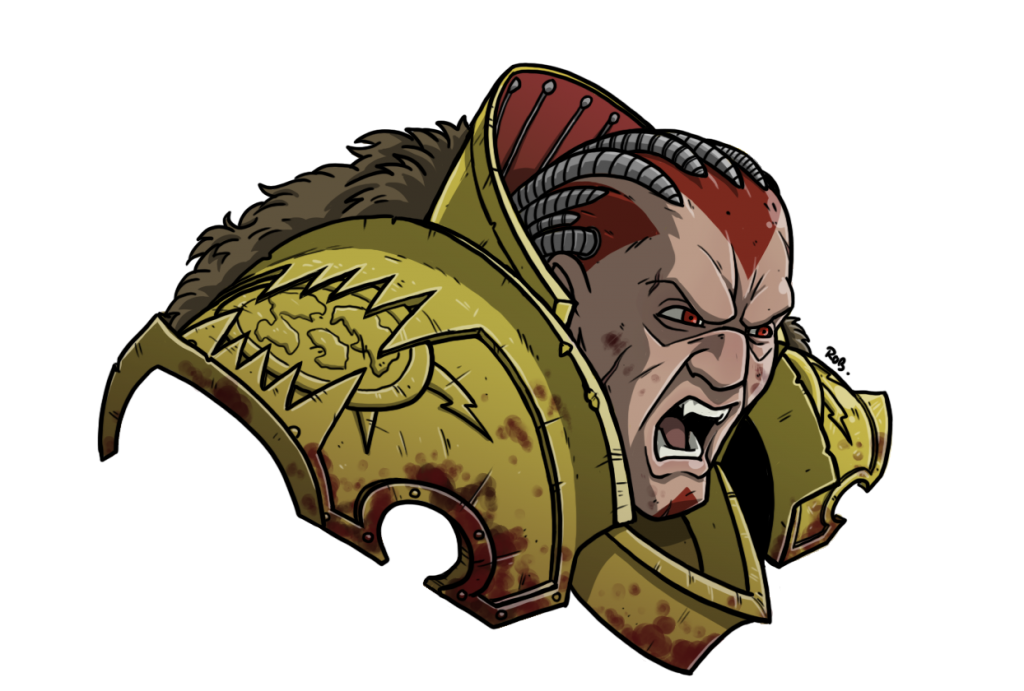
Future Arks of Omen books
We have seen the future and it involves you having to buy the other three books which will expand upon Boarding Actions with Faction-specific content and rules, plus any other expansions GW reveals beyond the books we know of.
Warhammer Community previewed the first three Arks of Omen books. The second Arks of Omen book is titled Angron and is due in ‘Winter’. The third is Vashtorr and is expected early Spring with the as yet titled Xenos book due late Spring.
Beanith: My best guess is the Angron book will contain the Faction-specific content and rules for Chaos Marines, Space Marines & Imperium; Vashtorr will cover Chaos Daemons, Admech and probably have the Necrons shoehorned in somehow. The 4th book is unnamed but ‘will be a distinctly xenos affair’, which I assume is code for it will be some horrific Xenos mashed burrito.
Aside from the Lore no doubt setting up some new stalemate, I am keen to see what Crusade content that may come along to expand upon this format.
Rob: I have thoughts on this and they’re not all positive. I’ll save them for the final thoughts section, though.

Final Thoughts
On the whole, Arks of Omen: Abaddon presents some exciting new developments in the lore of 40k, and sets up some interesting plotlines that we’re eager to see get more development. The Boarding Actions rules provide an interesting new way to play that seems like it actually makes 500-point games feasible. That said, there’s a snag here – while the concept and missions are very cool, they are gated behind having an entire set of boarding terrain purchased and assembled (but not glued together, since you need to change configurations).
That’s a considerable investment given that something like Battlezone: Fronteris – Nachmund is $220 and that the only other way to use the boarding terrain is in Kill Team or possibly Necromunda Zone Mortalis battles. The lack of Crusade content also means that the rules fit in this weird region somewhere between narrative and matched play. Players interested in a skirmish game inside a 2-D board can already play Necromunda or Kill Team, while players who might want a smaller game of 40k probably don’t want to drop upwards of $300 for terrain and a book.
![]() Rob: Having played a few games of Boarding Actions now, I can say that it’s a very fun game mode that really makes 500-point games viable. The action is brisk, with games taking around an hour, and the removal of Stratagems, Relics, and Warlord Traits means that it has a much lighter cognitive load than standard 40k or even Kill Team, and I actually think that Boarding Actions might be the ideal way to teach new players 40k. It’s also a great mode for any of your friends who insist that they don’t have the headspace for the complexity of 9th edition.
Rob: Having played a few games of Boarding Actions now, I can say that it’s a very fun game mode that really makes 500-point games viable. The action is brisk, with games taking around an hour, and the removal of Stratagems, Relics, and Warlord Traits means that it has a much lighter cognitive load than standard 40k or even Kill Team, and I actually think that Boarding Actions might be the ideal way to teach new players 40k. It’s also a great mode for any of your friends who insist that they don’t have the headspace for the complexity of 9th edition.
Having said that, the terrain is definitely an issue – it’s a big ask to assemble and paint two full sets of Gallowdark terrain, and the fact that GW have gone out of their way to explicitly tie missions to the terrain layouts makes it near impossible to adapt them to other layouts. The biggest problem isn’t even the terrain’s cost; it’s that it’s such a mondo pain in the ass to change the configuration that the idea of playing more than one mission per session of Boarding Actions is fairly repulsive – I just don’t want to deal with pulling apart a terrain layout to reorganize all of the walls and columns to play another mission. That’s a bigger deal to me than the cost, to be honest.
This is all a real shame because I honestly believe in this format, which has snappier play and refines actions into something that fixes their major issues. If Games Workshop made a version of this that used a 44×30″ board and came with non-Gallowdark terrain and allowed say, a single vehicle or something similar, I think they’d be able to create an exceptional introductory version of the game in a way that has eluded them before now. I like Boarding Actions, enough that I’m going to play more, but I’m also immediately thinking about how to make it work with Zone Mortalis terrain. I’m also concerned with how long it’ll get support, since this seems exactly like the kind of thing we get right before a new edition to pad out a release schedule.
![]() Primaris Kevin: As cool as the concepts and mission are, Arks of Omen really doesn’t appeal to me that much. I already have plenty of Sector Mechanicus and Zone Mortalis terrain for Necromunda, and I have no interest in Kill Team. That means that I would be buying Arks of Omen and the boarding terrain board exclusively for highly limited 500 point battles, and to be honest I don’t see a lot of interest in my local community for learning another set of rules when it’s much easier to just drop down 1000 points and use the Open War system for a casual game of 40k. This seems like something that would have been better off being sold as a boxed game, with cardboard terrain pieces that already contained the layout with 3-D door elements similar to how GW did the original Necromunda boxed set or the Rogue Trader Kill Team box.
Primaris Kevin: As cool as the concepts and mission are, Arks of Omen really doesn’t appeal to me that much. I already have plenty of Sector Mechanicus and Zone Mortalis terrain for Necromunda, and I have no interest in Kill Team. That means that I would be buying Arks of Omen and the boarding terrain board exclusively for highly limited 500 point battles, and to be honest I don’t see a lot of interest in my local community for learning another set of rules when it’s much easier to just drop down 1000 points and use the Open War system for a casual game of 40k. This seems like something that would have been better off being sold as a boxed game, with cardboard terrain pieces that already contained the layout with 3-D door elements similar to how GW did the original Necromunda boxed set or the Rogue Trader Kill Team box.
There’s also a really valid question of how long Games Workshop would support such a system. We’ve seen similar alternative means of play come and go, like Urban Conquest, Shadow War: Armageddon, or Cities of Death. Another perfect example of the lack of GW support was in Apocalypse, which in my opinion remains the best supplement GW ever released but didn’t so much as receive a single FAQ. To be honest it’s difficult to trust that GW will do anything but release Arks of Omen, see that nobody plays it, and then quietly forget it ever existed.
![]() Beanith: I want to love this, I want to be positive and I want to share the joy. I love the rules and think it’s a great way of getting in a few quick games of 40k. I like that cheap screening units look pretty good. It will be amusing to explain that “no you can’t see the Meganobz as those 5 gretchin bases are blocking your visibility”
Beanith: I want to love this, I want to be positive and I want to share the joy. I love the rules and think it’s a great way of getting in a few quick games of 40k. I like that cheap screening units look pretty good. It will be amusing to explain that “no you can’t see the Meganobz as those 5 gretchin bases are blocking your visibility”
But sadly GW has put on the hobnailed boots and is preparing to kick the ever living shit out your wallet with this release. At the time of writing this article we don’t know how much the four books or the terrain set will retail for but we can take an educated guess based on previous campaign books (£32.50/$55USD/$84AUD) and the Battlezone: Fronteris – Nachmund terrain set (£135/$220USD/$370AUD) assuming you’re lucky enough to get your hands on the Boarding Action terrain set when it launches. That’s a lot of money to spend just so you can play a few more 500 point games instead of a couple 1000+ point games.
Honestly my opinion is that this rule set should have been released as a booklet in a White Dwarf and then they could have drip fed the rest of the Faction-specific content over the next few issues. I doubt we’ll see any FAQs or a second print run of the Boarding Action terrain set for this series which is a shame because it looks like a lot of fun to play. So maybe organize a whip round your gaming group and chip in for the terrain and the books?
If you have any questions or comments feel free to drop us a note in the Comments below or email us at contact@goonhammer.com. That’s also the best way to suggest topics for future articles.
